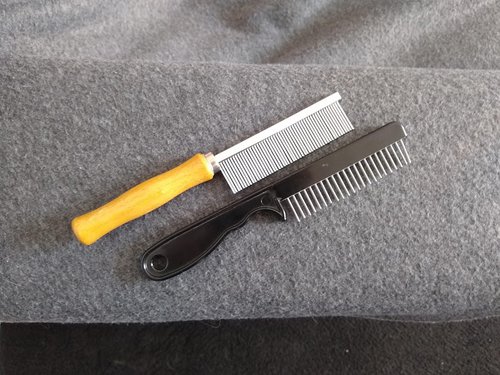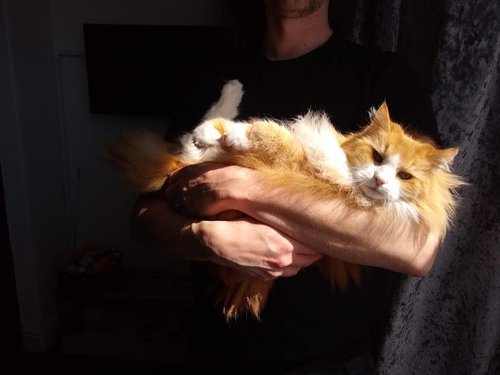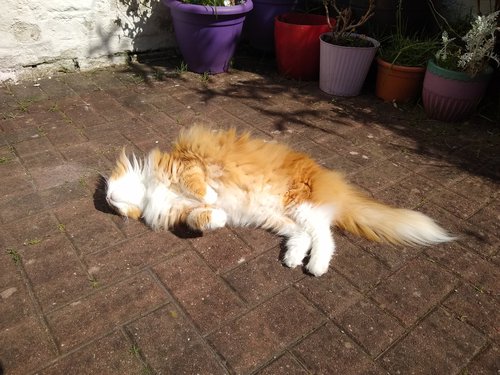Grooming your Cat
Grooming your cat can be a lovely experience for both you and your cat. However, tangles can be painful for cats as they pull on the skin. Then trying to get them out can be even more painful. Preventative grooming is best. Here are some tips to help.
Grooming your cat is important! Recently, I’ve seen a few social media posts about pets being cut with scissors when the owners have been trying to get out knots. I thought I’d write this blog to help prevent this from happening.
Before you read any further looking for the magic answer for grooming your cat, please be aware that cats personalities vary greatly! Some cats love being groomed whereas others have a reactive dislike. Don’t let this put you off though as the benefits in the long term are worth persevering.
Whether your cat is shorthaired or longhaired, grooming is required. Obviously, the length of hair relates to the amount of grooming required.
This article is only about the fur as nail cutting has been covered in a previous article. Click here for the nail article.
Benefits
- Bonding – Grooming your cat will help build up a relationship and create a bond. Watch carefully for the cats body language so you can see if it is not happy. If you aren’t sure what body language to look out for, have a look at the International Cat Care website.
- Fur maintenance – looking after the fur helps your cat to look after the fur itself. Grooming will help remove dust, dirt and loose fur.
- Matt prevention – Brushing prevents knots occurring and helps keep the coat healthy.
- Improves fur condition – stimulates circulation and skin oil production.
- Fewer fur balls – By removing loose hair, it means the pet won’t lick and swallow it. Less hair swallowed means that there will be less fur balls being brought up by the cat.
- Less moulting – By removing loose fur, it means it won’t be dropping off around the house.
- Physical benefits – circulation and muscle tone is improved.
- Health check – Getting up close with the cat, means you can check on the health of the pet. Keep an eye out for anything unusual in your cats body, fur condition or behaviour. This means that if there are any problems, hopefully, you will notice it early rather than later. Don’t forget to check in the ears and mouth.
- Parasite check - This is a great opportunity to check for pests and parasites even if preventative treatment is used. Look for the mini beasts or their droppings.
When to start
Start as soon as you can! The benefits are worth it for both you and your pet. The age and personality of the pet may have an affect on how they take to grooming.
If your cat gets covered in mess, it is useful if they are already used to being handled and groomed. (I’ll cover ‘big’ clean ups in another blog.)
How often?
This depends on your pet, how long their fur is, how fine their fur is and how your pet manages to groom itself.
I like to do a little bit of grooming but regularly. This way, she is used to being handled and I catch any problems early.
I keep a cat comb in the living room so it is always to hand. If my cat is rolling on her back in the sun, I take the opportunity to have a quick go in her armpits as these are the problem areas. She does like a good tummy rub.
What to use?

There are lots of combs on the market. The best one depends on how long the fur is and how fine it is. Also, the cat may have a preference on what is used as each will feel different.
If your cat is shorthaired, a grooming mitt, rubber brush or a plastic flea comb will be suitable.
For long fur, a brush or metal comb is best. There are various types of combs with different sized spaces between the prongs. The ones with wider spaces pull less if there are knots.
Getting the cat used to being touched
Try to get the cat used to being touched all over. This is obviously easier if you are starting with a placid cat or kitten. Other cats may need time to get used to it.
Though to be honest, some cats have a grumpy nature and will take longer to get used to it.
To start off with stroke the cat where it is happy for you to stroke it. Then gently, stroke the areas where it is less keen for you to touch.
Your gentle persistence is the key! (I am under no illusion that this may take some time.)
Finding the best time
Again, the best time to groom your cat varies depending on your cat. Distraction techniques are sometimes needed. It is a case of trial and error to find out what is best for your cat.
Some cats are more receptive after being fed as they are full, happy and content. One cat that I look after lets me start before she has her food. She then lets me do a bit more while she is eating and then that’s it. She won’t let me do any more grooming. (I usually try to feed cats last and I don’t mess with them while they are eating. This is the one exception!)
However, cats like to eat with four paws on the floor, so food isn’t a good distraction technique if you are trying to do the tummy area.
How to do it
Start in the areas that the cat is comfortable being stroked. Don’t brush hard so that the comb touches the skin.
Brush or comb in the direction that the fur goes – the direction you would normally stroke.
For long fur, lift up a section of the fur and then comb a small layer at a time. Comb in the same direction that the fur lies.
Make sure you do it gently as if it hurts the cat, then they won’t like it being done. Try and start at one end of the cat and work your way to the other. This helps the owner know what has been done.
I like to combine stroking the cat as well as combing and brushing. This helps keep the cat relaxed.
Be careful if the cat jumps up and moves as you don’t want to hurt it with the comb.
Tangles and Knots
The best way to deal with knots and matted hair is to deal with them while they are small. When you stroke your cat, have a feel all over every time to check if any knots have started.
Matts will tend to occur in the same place such as where the cat can’t reach to groom themselves or where they don’t like being touched. On my cat, she tends to get knots under her front legs in her ‘armpits’. This is a delicate area for her and it is so much easier to sort out while they are small.
When you find a knot, try to tease it out with a comb. Start combing at the end of the hair away from the body, then see if you can comb a bit closer to the body.
Once the matt is loosened, it may be easier to use your fingers to tease the knot out.
Carry on with the comb and fingers until it is removed. I find it is usually long loose fur that hasn’t fallen off the body that matts with the hair still attached to the body.
If the knot has been there for a while, the fur gets matted closer to the body. This means that it is more difficult and painful for it to be removed.
Don’t worry if the cat won’t let you remove the knot all in one go. It may take a couple of sessions as cats don’t like being in pain or touched where they aren’t keen.
Don’t use scissors as the cat may get cut and hurt. Cats tend to wriggle when sharp things are near their skin!
Two Person Job

If the knot is bad, it may be a two person job. One person to hold the cat and the other to work on the knot. The best way to do this will depend on the cat. If in doubt, take the cat to a vet or cat groomer.
On occasions, my husband holds Ginger in his arm like a baby so I can get to her armpit. This may not work for all pets.
Alternatively, get help from a professional groomer or a vet. When I worked at a vets, there was a long haired cat that had to come in every so often to be anaesthetised and completely shaved. She refused to be brushed. This is not a great situation to be in as has an effect on the cat and is costly/stressful for the owner.
My Cat

My cat Ginger has long hair, so often has fur ball sick. Fortunately, she has got an inbuilt warning system and gags a few times first. This means we’ve got time to try and grab a newspaper to catch it. She always has two fur balls to catch.
It isn’t very nice being sick, so I do my best to reduce this for her by removing the loose fur so she doesn’t swallow it. When I get the comb out, she gets up as she thinks she is getting treats. She only gets treats occasionally but she is always hopeful.
She quite likes being groomed but isn’t keen on some areas. I am continuing to try to get her used to it. Little and often is more tolerable for her. Sometimes she stops and grooms me. I am relaxed about how much I do – often will do one side in a session and then leave the rest until another day.
I am lucky as she is a laid back cat. She doesn’t like it when her nails are cut and will purr aggressively. This is also how she lets me know when she has had enough of grooming.
I hope you have found this article useful and the process of grooming your pet comes easier.
Any questions or if you have got further tips, please get in touch.
If you would like to sign up for my monthly newsletter, please sign up here.